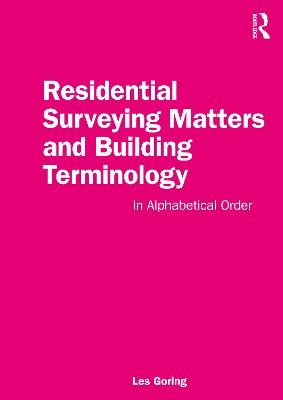
Residential Surveying Matters and Building Terminology
In Alphabetical Order
Seiten
2022
Routledge (Verlag)
978-1-032-25391-6 (ISBN)
Routledge (Verlag)
978-1-032-25391-6 (ISBN)
Residential Surveying Matters and Building Terminology covers a wide range of new and old building terms, techniques, technologies, and materials, but much more extensively than the average dictionary.
This is an ideal reference book for students (undergraduates and postgraduates) studying Building Surveying, Quantity Surveying, or Architecture, etc. It should also be of use to the Construction-related legal profession, Property Managers and Letting Agents. Builders (and homeowners, interested in identifying faults in their property), should also benefit from this book.
Residential Surveying Matters and Building Terminology covers a wide range of new and old building terms, techniques, technologies and materials, but much more extensively than the average dictionary. The alphabetical format makes it easy to check up on terms and subject-areas quickly – and the detailed coverage (including helpful drawings by the author) provides clear guidance to the reader.
This book covers a multitude of subject-areas, including condensation problems, cellar rot, wet rot and dry rot, thermal cracks, settlement cracks, metal wall-tie corrosion-and-expansion cracks, subsidence cracks, roof-spread recognition, bulging- and/or leaning-walls, etc. Further subject areas include inspecting and analysing residential building-structures, both internally and externally; appraising underground drainage systems; and personal commentary on survey report writing.
This is an ideal reference book for students (undergraduates and postgraduates) studying Building Surveying, Quantity Surveying, or Architecture, etc. It should also be of use to the Construction-related legal profession, Property Managers and Letting Agents. Builders (and homeowners, interested in identifying faults in their property), should also benefit from this book.
Residential Surveying Matters and Building Terminology covers a wide range of new and old building terms, techniques, technologies and materials, but much more extensively than the average dictionary. The alphabetical format makes it easy to check up on terms and subject-areas quickly – and the detailed coverage (including helpful drawings by the author) provides clear guidance to the reader.
This book covers a multitude of subject-areas, including condensation problems, cellar rot, wet rot and dry rot, thermal cracks, settlement cracks, metal wall-tie corrosion-and-expansion cracks, subsidence cracks, roof-spread recognition, bulging- and/or leaning-walls, etc. Further subject areas include inspecting and analysing residential building-structures, both internally and externally; appraising underground drainage systems; and personal commentary on survey report writing.
Les Goring is a member of the Chartered Institute of Building (CIOB), with a recent affiliation to the Royal Institution of Chartered Surveyors (RICS). He was a Senior Lecturer at Hastings College of Arts & Technology, having previously been a lecturer at South East London Technical College. In addition to being a Member of the Institute of Wood Science, he is also a Fellow of the Institute of Carpenters and a Licentiate of the City & Guilds of London Institute. Since 2007 until recently, he carried out Building Surveys in a jointly-partnered company named Residential Building Surveys Ltd.
Residential Surveying Matters & Building Terminology: A-Z
| Erscheinungsdatum | 08.09.2022 |
|---|---|
| Zusatzinfo | 82 Line drawings, black and white; 82 Illustrations, black and white |
| Verlagsort | London |
| Sprache | englisch |
| Maße | 174 x 246 mm |
| Gewicht | 860 g |
| Themenwelt | Naturwissenschaften ► Biologie ► Ökologie / Naturschutz |
| Technik ► Bauwesen | |
| Technik ► Elektrotechnik / Energietechnik | |
| Weitere Fachgebiete ► Handwerk | |
| ISBN-10 | 1-032-25391-6 / 1032253916 |
| ISBN-13 | 978-1-032-25391-6 / 9781032253916 |
| Zustand | Neuware |
| Informationen gemäß Produktsicherheitsverordnung (GPSR) | |
| Haben Sie eine Frage zum Produkt? |
Mehr entdecken
aus dem Bereich
aus dem Bereich
Planung · Recht · Verfahren
Buch | Hardcover (2024)
Springer Vieweg (Verlag)
64,99 €


